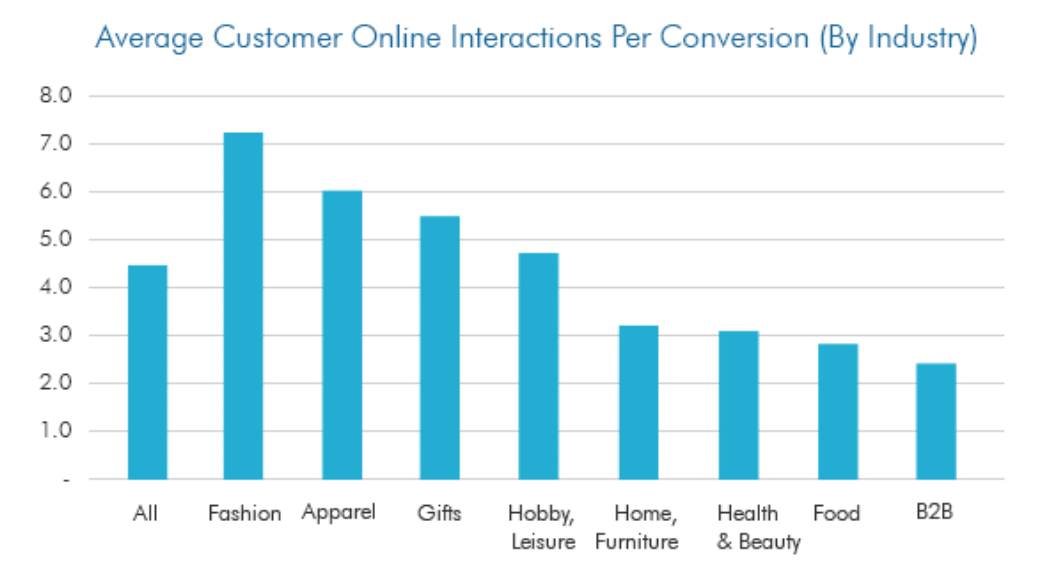Use attribution modelling to find out what percentage of your budget you should invest in your ad campaigns
An attribution model is a set of rules that determines how much credit is assigned to certain touch-points in conversion paths leading to sales and conversions. There are 7 attribution models that can be used in Google Analytics.
The first and last interaction models attribute all credit to the first and last touchpoint (respectively) before the conversion was made. For example, let’s say I was scrolling through Facebook and saw an ad for a pair of jeans, and then 2 days later I was still thinking about those jeans so I typed in a Google search and bought them online. The first interaction model would attribute all credit to the Facebook ad, whereas the last interaction model would attribute all credit to the Google search.
As you may be thinking, this doesn’t make a lot of sense, because clearly the Facebook ad is what would have prompted me to type in a Google search. Direct traffic is not really a traffic source or marketing channel, it is just the final action taken by customers as a result of marketing activity, so you usually shouldn’t give credit to direct traffic.
This is why the last non-direct click model gives all credit to the last touchpoint that isn’t direct. Direct traffic has no source information, meaning the user often typed the link straight into their search bar or had it already bookmarked. Non-direct traffic comes from known sources such as websites or ads. However, the last non direct click ignores influencers on the path to conversion.
The last google ads click model gives all credit to the last paid search channel click. For example, let’s say after I did my Google search, I clicked on a Google ad for Levi’s. Then 2 days later an ad for the same jeans came up on my Instagram feed which I clicked and proceeded to buy the jeans. The last google ads click model would give all credit to the Google ad.
The linear attribution model shares equal credit across each touchpoint: paid search, social network, email and direct channels. In this example, 33.33% of credit would be attributed to each touchpoint: the Facebook ad, the Google ad and the Instagram ad.
The time decay attribution model gives most of the credit to the most recent touchpoint before the sale or conversion. Credit then diminishes the further back in time you go. In this example, most credit would be attributed to the Instagram ad, less to the Google ad, and even less to the Facebook ad.
The position based model gives 40% of credit to the first touch point, 40% to the last touchpoint, and 20% to all other touch-points.
So how do you know what percentage of your budget to invest in your ad campaigns?
To determine which ad campaign is most successful, you will need to decide on which attribution model you want to focus on. The most effective model to use will vary across different companies, audiences and campaigns.
If you expect a long lead time with multiple touch-points, the first interaction model will not be appropriate because it would ignore the varied communication messages throughout your campaign.
If your focus is efficiency and making a quick sale, the last non direct click may be appropriate because you would expect to have a shorter lead time and less touch points.
If your focus is on growth, brand awareness and customer acquisition, the first touch attribution model would be appropriate to determine where you can first capture new users.
If your industry has a low level of buying consideration involved, such as fast moving consumer goods, the last non direct click model may be appropriate because there will be less touch-points or influencers on the path to conversion.
When there is a high level of buying consideration involved, such as clothing, it is important to consider the entire decision-making process. Therefore the linear attribution model or the position based model will be more accurate.

If you want to understand the effect of a limited time promotional campaign on the buying behaviour of your customers, the time decay model will be useful. This will allow you to consider the conversion path actions that are closely related to the promotional campaign.
Once you have chosen the most appropriate attribution model for your brand/company/campaign/audience, you can determine how much credit should be attributed to each touch point. From here you can then calculate the percentage of your budget you should invest into each touch point.
Check out SEO Sydney to learn more about a wide range of SEO-related topics today!







